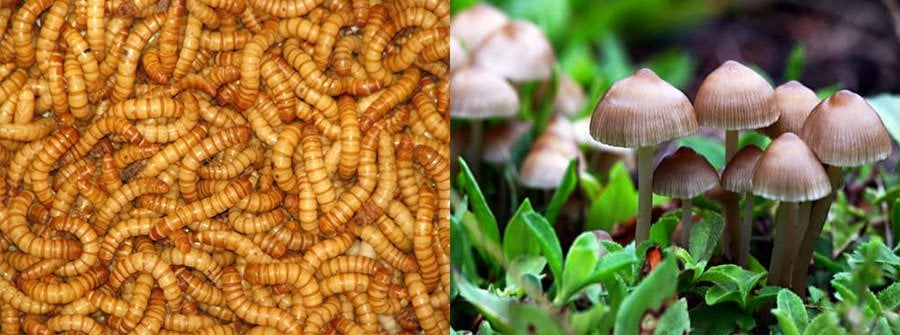
Discarded plastics and batteries pose substantial problems to the environment, but this week researchers have revealed two potential — if not surprising — tools we can use to reduce both their incidence and effects: mealworms and mushrooms.
Really, hear us out. This week, researchers at University of California, Riverside, Stanford University and Beihang University in China announced that the fungi and pests can be used to make better performing batteries and digest plastic, respectively.
Plastic-Eating Mealworms Might Help “Solve The Global Plastic Pollution Problem”
Regarding the mealworms, Stanford and Beihang researchers found that a certain bacteria in the worm’s gut allows it to digest Styrofoam and other plastic material — material which was considered to be non-biodegradable.
In the study, the mealworms consumed approximately 34-39 milligrams of Styrofoam each day, and converted half into carbon dioxide and within 24 hours excreted a majority of the rest as biodegraded droppings, according to a statement. As significantly, the plastic diet worms remained as healthy as their normal diet worm counterparts, researchers noted.
Converting a handful of milligrams into carbon dioxide or biodegraded droppings might not sound like a panacea to our pollution problem — and it isn’t — but it points to an entry point for further research that could help scientists “engineer more powerful enzymes for plastic degradation, including processing other kinds of currently impervious plastics like microbeads,” science blogger Peter Dockrill said.
And realistically, anything that can help curb the pernicious effects of the 2.5 billion Styrofoam cups Americans through away each year is worth trying out.
The researchers are currently looking for a marine equivalent of the mealworm, as there are as many as 5.25 trillion pieces of plastic in the ocean at present, Dockrill reported.
“Our findings have opened a new door to solve the global plastic pollution problem,” said study co-author Wei-Min Wu in a statement.
Energy Efficient Mushrooms
Meanwhile, researchers at University of California, Riverside Bourns College of Engineering have used Agaricus bosporus species, or the portobello mushroom, in a new lithium-ion battery anode (think of it as the device that an electric current uses to enter a battery), and are encouraged by their results.
Not only are the mushroom anodes less expensive and environmentally damaging, they have the potential of being more efficient than their standard synthetic graphite counterparts, Discovery News reported.
Due to the mushroom anodes’ porous nature, they create more space for the storage and transfer of energy. Likewise, their high potassium salt content helps keep the pores activated over a longer period of time, the Latest News reported. Taken together, this means that these “mushroom batteries” could result in improved battery performance — so much so that batteries become more efficient over time.
“With battery materials like this, future cell phones may see an increase in run time after many uses, rather than a decrease, due to apparent activation of blind pores within the carbon architectures as the cell charges and discharges over time,” researcher Brennan Campbell said in a statement.
As with the plastic-eating mealworms, on first blush this development might not sound that significant. But if you consider how the demand for and use of battery-powered devices is slated to increase dramatically as highly-populated countries like India become wealthier, so does the potential for electronic waste. This in turn means that any efficiency enhancing measures one can take on the supply side — such as improving battery power and energy usage — is a must for cutting production costs to make these devices more affordable for more people while simultaneously reducing toxic waste.
Said Stanford professor Craig Criddle, “There’s a possibility of really important research coming out of bizarre places. Sometimes, science surprises us. This is a shock.”
So there you have it — mushrooms and mealworms, providing some seemingly unlikely environmental aid.




